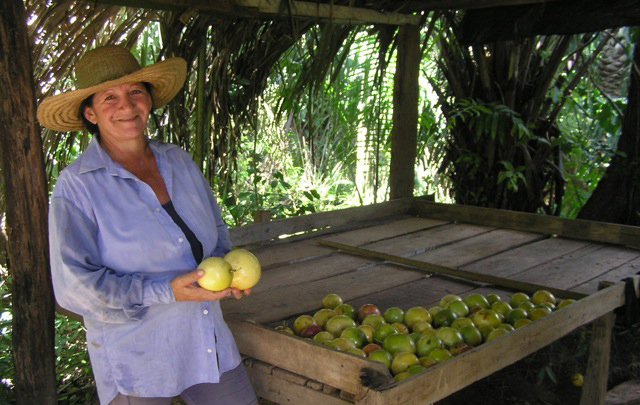Photo Above: Farmer Dona Madalena with a crop of passion fruit sold through the farm to school program in Tangara de Serra, Mato Grosso, Brazil. Photo by Hannah Wittman.
When Hannah Wittman first started traveling to Central Brazil more than a decade ago, she was astounded at the sheer tenacity of the small family farmers she met there. These were the “poorest of the poorest;” people who had been granted land through a constitutional provision that came into effect in the 80s. The idea was that unused land should be expropriated for the purpose of agrarian reform. What these landless workers ended up with, however, was typically undesirable by farming standards: poor soil, high in the forest, far from urban markets.
But they made it work. And over the past ten years, Wittman – an associate professor of food, nutrition and health at the University of British Columbia – has witnessed how many have been able to go from subsisting to earning a living through a unique school meal program.
Brazil’s national school meal program has been feeding kids for more than half a century. Launched in 1955 as a welfare strategy to mitigate the effects of poverty, in recent years it’s been expanded as a tool for economic development.
In 2003, under then-president Luiz Inácio Lula da Silva, Brazil introduced a public food acquisition program which included not just schools but community centres, food banks and other charitable associations. Then in 2009, parliament passed a new law requiring that 30 per cent of the food purchased by the federal government for school meal programs come from small family farms. That year, procurements totaled $337 million, and included 130,000 small family farms.
Brazil’s approach has caught the attention of one of the world’s top authorities on food security: Olivier de Schutter, the United Nation’s Special Rapporteur on the Right to Food. Brazil featured prominently in his most recent report, The Power of Procurement [http://www.srfood.org/images/stories/pdf/otherdocuments/20140514_procurement_en.pdf], which called on governments to help create a more fair food system by building markets for local sustainable foods through public institutions: schools, hospitals and campuses. From a health perspective, from an education perspective and from an economic development perspective, noted de Schutter, local procurement on a federal scale is a worthwhile investment.
Wittman has seen the evolution of the program and how it’s affected farmers there. In this interview with Farm to Cafeteria Canada, she shares what she’s learned, and what we could learn from this innovative program.
How does it work?
They [the national school meals program and the public food acquisition program] are both institutionalized avenues for getting food from very poor small-scale farmers who don’t have the individual scale to deliver food into towns on their own. In both cases, there is funding by the federal government to enable localization of food systems, support from municipal governments on local logistics and then cooperative organization by farmers themselves.
Think about it like a three-part partnership: any one of those pieces isn’t enough. You have to have farmers organized to combine their production — alone they don’t have enough. You also need municipal logistics; simple things like roads, bridges, a warehouse, someplace to sort and clean all the food. And then the support from the federal government to actually buy the food.
How has this program affected the farmers you’ve worked with?
We did a detailed evaluation of how it’s affecting production practices. We did a survey of those participating [in the program] and those who are not. One of the most interesting results we found was that farmers who are participating have a more highly diversified production system. They’re growing more kinds of things, and have more stable incomes. It gives them a cushion. If they have a crop failure, there are other crops. Overall, farmers really like this program. They find it a much better income than selling to a middle-man or wholesale distributors, many of whom won’t go out to very rural areas.
How does this compare to the Canadian context?
Here in Canada, students and parents are saying we want local food in the schools, and the Local Food Act [in Ontario] http://www.ontla.on.ca/web/bills/bills_detail.do?locale=en&BillID=2754 is saying we want local food in the schools, but we don’t have a good mechanism for making that happen.
I think the distribution thing is the puzzle. What we have here is a wholesale distribution system that pays farmers very low prices. The alternative to that is a farmers’ market. We’re missing the middle. We’re missing something in the middle that can be a liaison between local food that is branded and has an identity, but that also provides that distributive function. We’re talking about a marketing co-op, or a food hub, or something that can perform that service in a non-profit way.
What’s happening in Brazil is that the government has become the distributor. We’ve seen over the evolution of the program that the municipal government will say, ‘OK, we will for two years send a truck out once a week.’ And what we’ve seen is, once you’ve got that set up, after a while farmers get organized enough to pay for their own trucks.
These people are producing a lot of valuable and healthy food that could be utilized in these nearby urban environments. They just needed a way to get it to the schools. It’s kind of a win-win. It’s a win for the urban environment, because they’re getting local, culturally appropriate food that is fresher, and then the local community is getting a little bit of income. And that money coming in is being invested in the community, in the farms.
Are there any particular people you met that really inspired you?
Well they all do. They’re very inspiring. We’re talking about people that had nothing. They were the poorest of the poorest people in Brazil. They had no land, they had no jobs. Brazil has a constitutional provision that if the land is not used productively, it is redistributed to landless people; this has been in effect since the 80s. What they ended up with were really bad pieces of land, really high in the forest, and they’ve made it after all these years.
They were able to make the land productive regardless of the program, but they were subsistence farmers. Their biggest challenge was, how do you actually market that produce when you don’t have distribution? They didn’t have any way to get cash. What this program did was fill in this missing piece of the distribution structure that allowed them to actually earn a livelihood and then support local economic development. It’s adding that level of economic activity. A lot of them said these public procurement programs were one of the best things they ever had.
What could we learn from this?
It’s shocking to me that Canada is the only G8 country without a school food program. I have a student from Brazil who wants to research school food systems, and one of his tasks is to investigate why is it that Canada does not have a school food program.
Interestingly, in Brazil it was the urban nutritionists who had the leverage to get this [public food acquisition program] passed. The farmers had been asking for this for years and years and years. In 2003, a new government came in, and the urban nutritionists said we support this. The program was a link between urban nutritionists and local business. It was a link between social economic development and health. I think it was that nice coordination between the public health sector and the agricultural sector that had been previously siloed in different worlds. They understood they could come together and ask for the same thing.
The views expressed in this article may not necessarily reflect those of Farm to Cafeteria Canada.






[…] In 2003, under then-president Luiz Inácio Lula da Silva, Brazil introduced a public food acquisition program which included not just schools but community centres, food banks and other charitable associations. Then in 2009, parliament passed a new law requiring that 30 per cent of the food purchased by the federal government for school meal programs come from small family farms. That year, procurements totaled $337 million, and included 130,000 small family farms. Farm to Cafeteria Canada post. […]